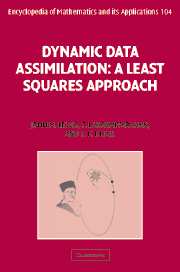Book contents
- Frontmatter
- Contents
- Preface
- Acknowledgements
- PART 1 GENESIS OF DATA ASSIMILATION
- 1 Synopsis
- 2 Pathways into data assimilation: illustrative examples
- 3 Applications
- 4 Brief history of data assimilation
- PART II DATA ASSIMILATION: DETERMINISTIC/STATIC MODELS
- PART III COMPUTATIONAL TECHNIQUES
- PART IV STATISTICAL ESTIMATION
- PART V DATA ASSIMILATION: STOCHASTIC/STATIC MODELS
- PART VI DATA ASSIMILATION: DETERMINISTIC/DYNAMIC MODELS
- PART VII DATA ASSIMILATION: STOCHASTIC/DYNAMIC MODELS
- PART VIII PREDICTABILITY
- Epilogue
- References
- Index
2 - Pathways into data assimilation: illustrative examples
from PART 1 - GENESIS OF DATA ASSIMILATION
Published online by Cambridge University Press: 18 December 2009
- Frontmatter
- Contents
- Preface
- Acknowledgements
- PART 1 GENESIS OF DATA ASSIMILATION
- 1 Synopsis
- 2 Pathways into data assimilation: illustrative examples
- 3 Applications
- 4 Brief history of data assimilation
- PART II DATA ASSIMILATION: DETERMINISTIC/STATIC MODELS
- PART III COMPUTATIONAL TECHNIQUES
- PART IV STATISTICAL ESTIMATION
- PART V DATA ASSIMILATION: STOCHASTIC/STATIC MODELS
- PART VI DATA ASSIMILATION: DETERMINISTIC/DYNAMIC MODELS
- PART VII DATA ASSIMILATION: STOCHASTIC/DYNAMIC MODELS
- PART VIII PREDICTABILITY
- Epilogue
- References
- Index
Summary
This chapter complements Chapter 1 by providing a bottom-up view of data assimilation through illustrative examples – one for each of the four classes of problems introduced there. We also include a discussion of problems associated with sensitivity and predictability. Using the standard least squares formulation, we provide a natural and intuitive interpretation of the solutions to these problems.
Least squares
The central criterion used in data assimilation is least squares. As stated earlier, it arose 200 years ago and history has bestowed simultaneity of discovery on both Gauss and Legendre. It assumes a variety of forms, but its fundamental tenet in data assimilation is minimization of the squared departure between the desired estimate and observations and/or other “background” information (typically a forecast). It was built on the foundation of variational calculus, the branch of mathematics that explores minimization of integrals – for example, integrals that express the path of quickest descent (the brachistichrone problem), path of least time (refraction of light), and the principle of least action. As such, there is a rich heritage of applied mathematical methods that can be brought to bear on these minimization problems.
Deterministic/Static problem
In its simplest form, the solution of a data assimilation problem underpinned by least squares reduces to averaging the observations. It is no more or no less than the “carpenter's rule of thumb”: the best estimate of a length measured more than once with the same instrument is the average of the measurements. Let's put this adage in the context of a dynamical law where we choose the nonlinear advection constraint of Burgers (see Chapter 3).
- Type
- Chapter
- Information
- Dynamic Data AssimilationA Least Squares Approach, pp. 27 - 50Publisher: Cambridge University PressPrint publication year: 2006

